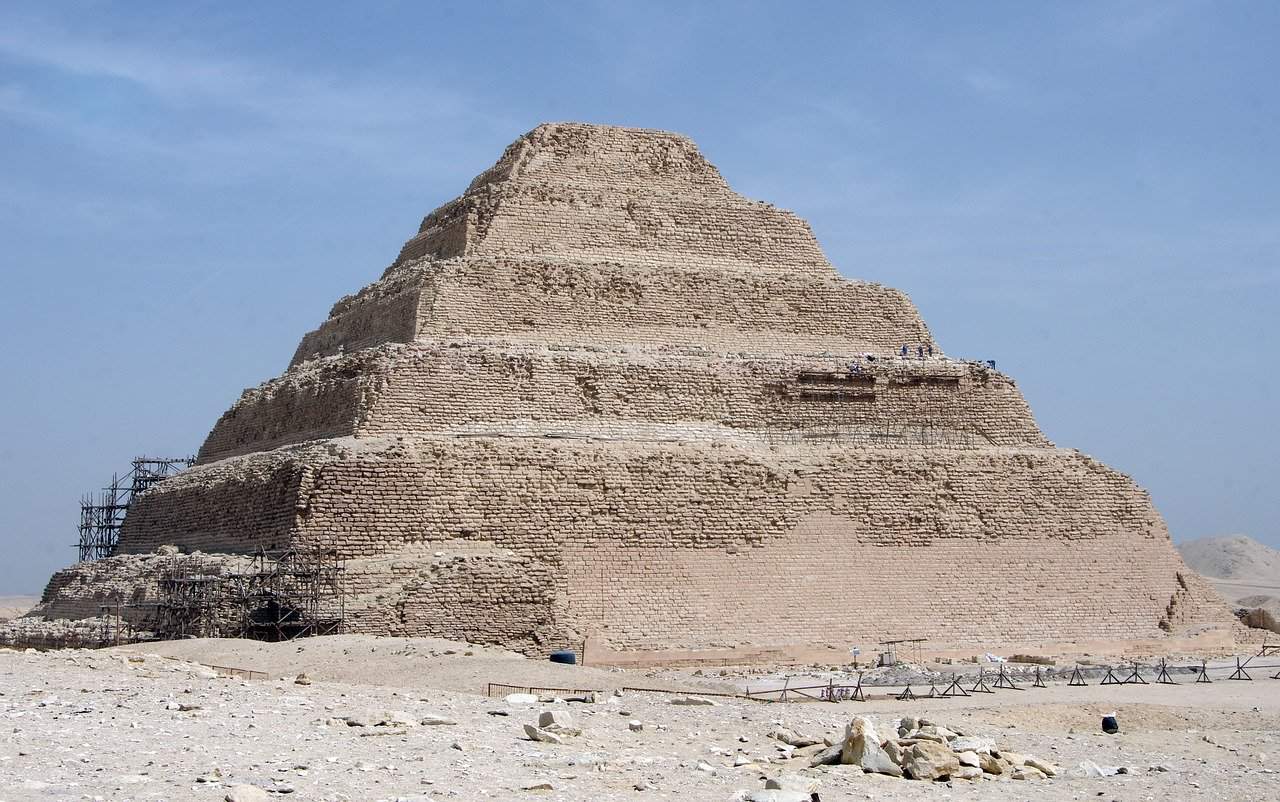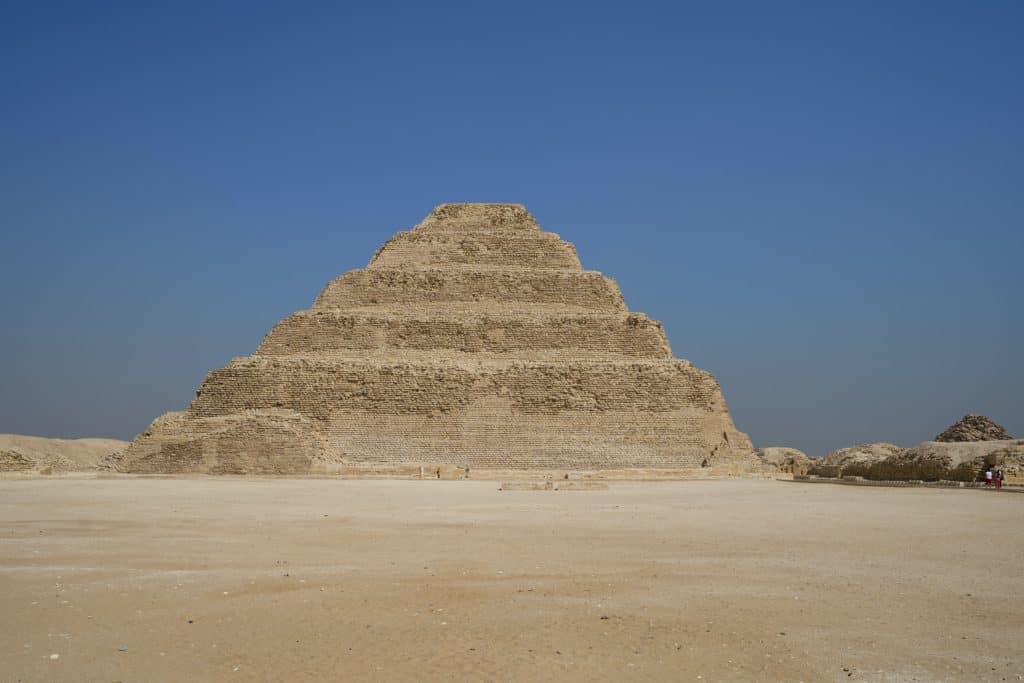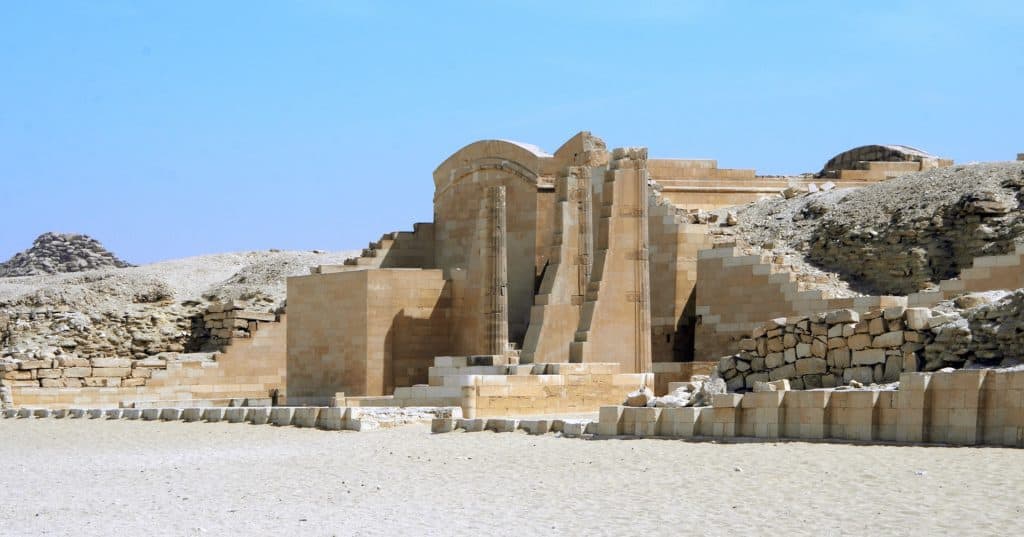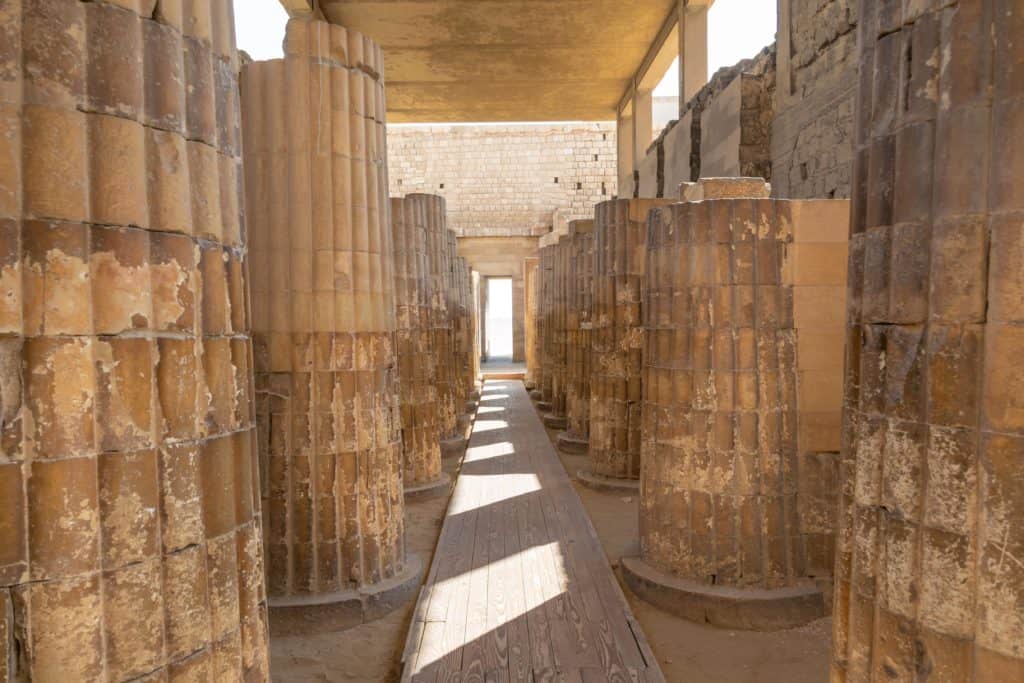What You Need to Know about the Astounding Pyramid of Djoser in Saqqara – 6 Facts and More

Updated On: March 11, 2024 by Dina Essawy
Located south of modern Cairo, the Step Pyramid of Saqqara lies on the west bank of the Nile River and is over 6 km long and more than 1.5 km wide. The pyramid, named after Djoser, the first king of the 3rd Dynasty, is the last of what remains of the Saqqara Necropolis, a pretty extensive system of cemeteries that spanned the modern sites of Dahshur, Giza, and Abusir.
Initially built during the reign of the 1st Dynasty, the area continued to be used for burial for over 3000 years. Since the possibilities of excavating new antiquities in Egypt are endless, the remains of a temple dedicated to the goddess Bastet are buried below what is now a parking lot on the top of the Bubastieion cliffs.
Djoser’s mortuary temple was built on the northern side of the pyramid, where daily rituals for the dead were performed, and offerings were presented to the pharaoh in the afterlife. The mortuary temple faced north as it was believed the pharaoh would become one of the eternal stars in his afterlife.

An Influential King Way Ahead of His Time
Djoser was the son of King Khasekhemwy and Queen Nimaathap. However, there is still much debate on whether he was the first or second king in his line of succession.
Djoser’s wife was Hetephernebti. Defying the tradition of choosing a queen and several lesser wives, he remained faithful to only one woman, Hetephernebti.
A painted limestone statue of Djoser, found within the Djoser Pyramid during the excavations carried out in 1924–1925, can now be found at the Egyptian Museum in Cairo. It is the oldest known life-sized Egyptian statue.
The length of Djoser’s reign has also been a matter of much debate. Due to many substantial building projects, particularly at Saqqara, some scholars argue that Djoser must have ruled for at least three decades.
“Historian Margaret Bunson notes that Djoser” ruled during an age witnessing advances in civilization on the Nile such as the construction of architectural monuments, agricultural developments, trade, and the rise of the cities”.” Historian Margaret Bunson notes that Djoser “ruled during an age witnessing advances in civilization on the Nile such as the construction of architectural monuments, agricultural developments, trade, and the rise of the cities”.
Political Life During Djoser’s Reign
During his reign, Djoser dispatched several military expeditions to the Sinai Peninsula to subdue the locals. He also sent expeditions there to mine for valuable minerals such as turquoise and copper.
Djoser’s pyramid set a precedent for later construction work in the era. These forms eventually led to the standard pyramid tomb in the last Old Kingdom. Furthermore, it ended the custom of burying pharaohs in Abydos. Instead, they chose burial grounds in the North, following Djoser’s lead.
Djoser was also the first pharaoh to reside exclusively in Memphis, helping make it the political and cultural centre of the Old Kingdom of Egypt.
Egypt witnessed political stability during his reign as he successfully secured and extended the country’s borders.
The Step Pyramid of Djoser
The Step Pyramid of Saqqara (Djoser) was ahead of its time. Historian Mar Van de Mieroop concludes, “Earlier complexes at Abydos and Saqqara near Memphis had been massive, but they were of mud brick. A few elements only were of stone. Djoser’s Step Pyramid complex at Saqqara was the earliest construction of its size in world history entirely made of stone…Imhotep reproduced in stone what had been previously built of other materials.
“The facade of the enclosure wall had the same niches as the mud brick tombs; the columns resembled bundles of reed and papyrus, and stone cyliners at the lintels of doorways represented rolled-up reed screens. Much experimentation was involved, which is especially clear when constructing the pyramid in the centre of the complex. It had several plans with mastaba forms before it became the first Step Pyramid in history, piling six mastaba-like levels on top of one another…
The weight of the enormous mass was a challenge to the builders, who placed the stones at an inward incline to prevent the monument from breaking up”.”The facade of the enclosure wall had the same niches as the mud brick tombs; the columns resembled bundles of reed and papyrus, and stone cyliners at the lintels of doorways represented rolled-up reed screens. Much experimentation was involved, which is especially clear when constructing the pyramid in the centre of the complex. It had several plans with mastaba forms before it became the first Step Pyramid in history, piling six mastaba-like levels on top of one another…The weight of the enormous mass was a challenge to the builders, who placed the stones at an inward incline to prevent the monument from breaking up”.

Imhotep Museum
The museum features a documentary film produced by National Geographic. Imhotep was Djoser’s chancellor, the high priest of the sun god Ra at Heliopolis, and the person responsible for the design and construction of the pyramid dedicated to his monarch.
The pyramid of Djoser is considered a revolutionary design since, before then, pharaohs were buried in rectangular mastabas. However, Imhotep created a pyramid by stacking six mastabas on top of each other. This design would later evolve into the smooth-sided pyramids seen at Giza and elsewhere.
The site was even considered an attraction in ancient times, as evidenced by ancient graffiti; people came here as tourists and pilgrims from as early as the Middle Kingdom (2040-1640 BC), if not earlier.
Imhotep was so revered that his status had risen to the god of medicine and healing two thousand years after his death.
Not only was Imhotep skilled in architecture, but he was also known as a polymath, poet, judge, magician, scribe, astronomer, and physician.
“Egyptologist James Peter Allen said, “The Greeks equated him with their god of medicine, Asklepios, although ironically, there is no evidence that Imhotep himself was a physician.”Egyptologist James Peter Allen said, “The Greeks equated him with their god of medicine, Asklepios, although ironically, there is no evidence that Imhotep himself was a physician.”
The Famine Stele
The Famine Stele is an inscription that dates back to the Ptolemaic Dynasty, which tells the story of how a king saved his country. According to the inscriptions on the stele, a famine broke out in Egypt for seven years.
No one could figure out a solution to the disaster until Djoser had a dream in which the god Khnum, god of the source of the Nile River, came to him and complained that his temple on the island of Elephantine had been left in ruins and disrepair and people had lost their respect for the god who had given them life through the river Nile.
Djoser consulted with his counsellor, Imhotep, and they both decided that Djoser should sail to the island of Elephantine to pay his respects to Khnum and oversee the plans to repair the temple. Djoser eventually ordered a new temple to be erected in its place. The famine ended once the new temple was constructed, and his people hailed Djoser as a hero.
Although the Stele is primarily regarded as a legend not based on actual events, it still attests to Djoser’s popularity among his people and how he is remembered thousands of years afterwards.
Burial Chamber of Djoser Pyramid

The tomb chambers were dug to form a maze of tunnels to discourage robbers and protect the body and grave goods. Djoser’s burial chamber was carved of granite, and to reach it, one had to navigate the corridors, which were filled with thousands of stone vessels inscribed with the names of earlier kings.
Although the opening to the tomb was sealed with a 3.5-ton block after Djoser’s burial and despite the extreme care taken during the design and construction of the pyramid to ensure the safety of the pharaoh’s body, it was still extensively robbed. Nobody was found inside, suggesting that the thieves had found the pharaoh’s body and stolen it as well.
Cairo contains the grand Pyramids of Giza and many more exciting attractions and landmarks to explore. For example, this beautiful and equally fascinating pyramid with a lot of history and myth has attracted visitors, researchers, tourists, and Egyptologists. You won’t miss stopping at Djoser Pyramid in Saqqara on your trip around Cairo, Egypt.
Restoration and Conservation Efforts
Despite standing for over 4,600 years, the Pyramid of Djoser has not been immune to the ravages of time and environmental factors. In recent years, efforts have been made to preserve and restore this ancient monument, ensuring its survival for future generations. Restoration projects have focused on stabilizing the structure, reinforcing weakened areas, and protecting it from erosion and decay. These efforts underscore the importance of safeguarding our cultural heritage and preserving the legacy of ancient civilizations.
Unlocking the Mysteries
While much has been learned about the Pyramid of Djoser through centuries of archaeological study, many mysteries remain shrouded in its ancient stones. Questions persist regarding the purpose and significance of certain architectural features, the rituals performed within its sacred precincts, and the identities of the countless artisans and labourers who contributed to its construction. Ongoing research and excavations promise to unveil new insights into the history and culture of ancient Egypt, adding to the tapestry of human knowledge.
A Timeless Symbol
As one of the most iconic landmarks of ancient Egypt, the Pyramid of Djoser continues to inspire wonder and fascination in all who behold it. Its towering silhouette against the desert sky serves as a poignant reminder of the achievements of past civilizations and the enduring legacy of human ingenuity. Whether viewed as a testament to the divine authority of pharaohs or as a symbol of human aspiration and creativity, the Pyramid of Djoser remains an eternal symbol of Egypt’s rich cultural heritage.
Conclusion
In the heart of the Saqqara necropolis, the Pyramid of Djoser stands as a testament to ancient Egypt’s architectural prowess and cultural sophistication. From its groundbreaking design to its enigmatic origins, this ancient marvel continues to captivate the imagination of scholars and visitors alike. As we unravel the mysteries of this extraordinary monument, we gain a deeper understanding of the complexities of ancient Egyptian society and the enduring legacy of its civilization. In the footsteps of Pharaoh Djoser and his visionary architect Imhotep, we embark on a journey through time, exploring the wonders of one of the world’s most extraordinary architectural achievements.






